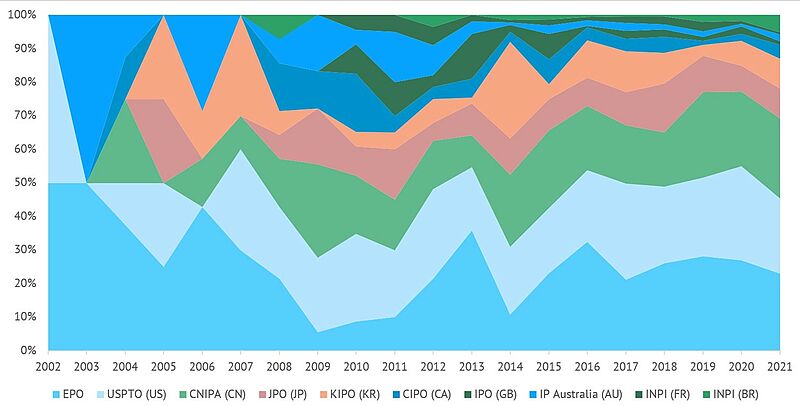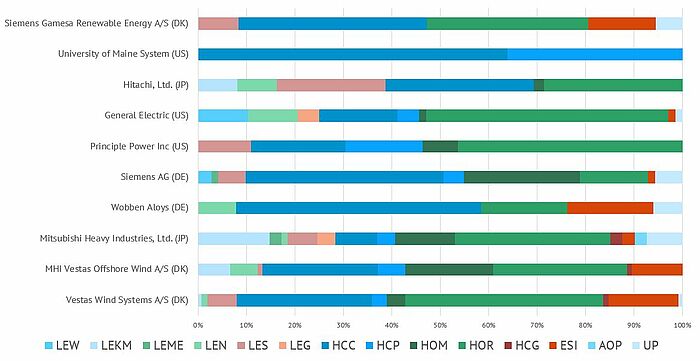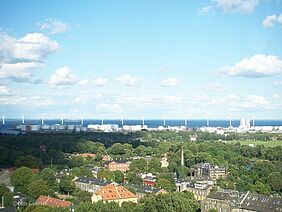One of the main barriers to the development of wind energy is its low capacity factor, which in real practice rarely exceeds 30%. The leading trends in the development of wind energy are the increase in the size of wind turbines and construction of wind farms in offshore zones, which allows the maximum capacity factor to be achieved. Thus, one of the largest offshore wind turbines – Haliade-X, developed by General Electric, have a tower height of over 260 meters and a rotor diameter of 220 meters. Offshore wind energy is of particular interest and has a huge resource potential. In 2021 the total installed capacity of offshore wind energy exceeded 56 GW, but this only amounted to slightly more than 7% of the total capacity, including onshore wind turbines. According to the forecast of IRENA, in its dynamic scenario, offshore wind energy capacities can increase to more than 500 GW by 2050.
At the same time, the successful installation and operation of offshore wind turbines requires additional organizational efforts and financial investments. This is primarily due to the fact that the installation, operation and repair of multi-ton marine structures reaching several dozen meters requires special equipment, staff training, as well as timely improvement of existing technology. It should be especially noted that the maintenance, repair and replacement of parts for wind turbines are the most vulnerable technological aspects on the way to achieving their maximum workload, which still remains low. In addition, these activities account for a significant share of operating expenses. Therefore, ensuring the high reliability of all structural elements, especially the blades, is a paramount task in the development of the component production for wind turbines and their operation.
Lillgrund Offchore Wind Farm, Sweden, 48 wind turbines, 110 MW
A significant part of effective technical solutions aimed at the development of these technologies is concentrated in patent documents registered with various patent offices. EnerTechUp company performed a systematic search of patent documents on this subject, prepared a unique patent database, and conducted a thorough statistical analysis of the patenting activity results. The database "WIND ENERGY. Offshore Wind Turbine" includes patent documents that were carefully collected from the publicly available sources and, according to the authors, to the greatest degree represent the latest innovations in the particular energy industry as of the date of the database preparation. The database includes more than 5.5 thousand patent documents during 2001 and 2022 and also includes statistical analysis for major parameters of patent documents published during the 20-year period between 2002-2021. In particular, the statistical analysis includes a breakdown of documents by publication dates, by patent families, by patent offices, by residents and non-residents, and by applicant countries.
Statistical analysis includes:
Inventions: 5612
Offices: 42
Countries: 32
Applicants: 982
The main body of the patent documents were registered between 2015 and 2019 with a peak of patenting activity in 2018. With rare exceptions, EPO and USPTO (US) patent offices annually were the leaders by the number of granted patents. However, in the last years maximum number of patent applications were registered in CNIPA (CN).
Breakdown of documents by patent offices. Patents, 2002-2021
The highest activity in patenting their inventions was demonstrated by the residents of Denmark with a share of more than 19% of the total number of applicants who were granted patents during 2002-2021. Among other countries whose residents were granted at least one hundred patents were Germany, United States, Japan, China, Spain and France.
The most popular IPC subgroup with a share of almost 6% was F03D1/00 – Wind motors with rotation axis substantially parallel to the air flow entering the rotor. Device as a type of technical solution was mentioned in almost 61% of patented inventions; different methods were mentioned considerably less often – in 39%.
Breakdown of documents by technology elements (by the number of mentions in patent documents). Patents, 2002-2021 (left). Applications, 2017-2021 (right)

B - Blades and components thereof, EE - Electrical equipment and generators, SE - Structural elements, CSS - Control and safety systems, ESH - Energy storage and hybrid generation systems, AC - Aerodynamic casings (nacelles, shrouds, etc.), GT - Gearbox and transmission, MRR - Maintenance, repair and replacement, OTE - Other technology elements, R - Rotors and components thereof
A separate portion of the statistical analysis is dedicated to applicants of patent documents. It includes the lists of applicants separately for patents and applications, breakdown of applicants' patent documents by offices, by types of technical solution, by problems, by technology categories, by IPC sections.
The list of top 10 most productive applicants by the number of patents includes:
Vestas Wind Systems A/S (DK)
MHI Vestas Offshore Wind A/S (DK)
Mitsubishi Heavy Industries, Ltd. (JP)
Wobben Aloys (DE)
Siemens AG (DE)
Principle Power Inc (US)
General Electric (US)
Hitachi, Ltd. (JP)
University of Maine System (US)
Siemens Gamesa Renewable Energy A/S (DK)
Breakdown of applicants by problems. Patents, 2002-2021 (by the number of mentions in patent documents)
LEW - Low efficiency caused by wind variability, LEKM - Low kinetic-to-mechanical power conversion efficiency, LEME - Low mechanical-to-electric power conversion efficiency, LEN - Low efficiency caused by secondary natural factors, LES - Low efficiency of secondary equipment, LEG - Low efficiency in general, HCC - High CAPEX / Plant construction, HCP - High CAPEX / Equipment production, HOM - High OPEX / Operational maintenance, HOR - High OPEX / Repair and replacement, HCG - High costs in general, ESI - Environmental and social impact, AOP - Administrative and organisational problems, UP - Unclear problem
The concluding part of the analysis includes calculated data that allow the resulting patenting trends to be exposed and main conclusions to be drawn. Such diagrams as relationship of number of applicants to number of patents by year, relationship of number of single applications to total number by year, new applicants by year, top new IPC subgroups, and others, are presented here.
Share ratio coefficient of invention types (Relationship of number of applications to total number of documents by year)
This Database serves as one of the variants to monitor advanced technical achievements in the specified industrial sector. The statistical data, rating evaluations and carefully selected patent documents provided in the Database can be of interest for inventors, engineers, researchers, students and educators, as well as for businesspersons and investors, who in one way or another are concerned with the problems of the development of wind energy production technologies.
A complete version of the database can be found at www.aenert.com
